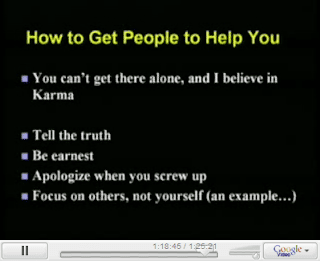In
Brian Crosby's video, we learn that he makes students accountable for their own education. He makes and assigns fun projects to keep his students interested. A fun project he created for his students was the High Hopes Project. This project allowed the students to take full responsibility and complete this project independently. They had to contact other students from different schools through only blogs. One of his main points from his lecture was to empower students to learn on their own. He mentioned that throughout a classroom, there is always a way for students to not only learn, but participate as well. The most important thing we learned from Mr. Crosby was when he lectured about high test scores. He believes that high test scores do not mean a more fun classroom or better education. He believes that a great education comes from birthright, rather than students attending a school with high scores.

In
Blended Learning Cycle video, I learned that there are 5 E’s to learning science: engage, explore, explain, expand, and evaluate. The five E’s can be blended with online resources and classroom instruction. The learning blended cycle is created by combining the blended classroom and the 5 E’s. The video instructs us that it is okay to stop and make sure we have an understanding of what is going on. As a future teacher, we want our students to be able to take what they have learned and apply it to daily experiences. Mr. Paul Anderson states that blended learning is taking the techniques of online, mobile, and classroom learning and blending them together. Two things were presented in this video. One was the power of the question and the other was the power of learning. There are many ways to do it, such as start with a good question and/or hook. You have to have something that will get the students attention right off the bat. Next, you want the students to investigate, experiment, and use inquiry learning. You have a video, elaboration, review, and summary quiz. Mr. Anderson had several good points in his video. We think the Blended Learning Cycle is a great tool that will be very helpful in the classroom. It is a great approach for students to learn something and to help the students who are not so engaged in learning become more engaged.
After watching Mark Church's video on "
Making Thinking Visible," we have learned that by giving students a driving question to focus on is a great way to begin a project. I believe it is very useful to actually give a question and have the children research and collaborate as a group. I really like how Mark Church had each group come up with a headline and share it with the class. By doing this, it allows the students to hear from each other and look into the topic in different perspectives. I also think that by looking at their headline two weeks from the beginning of the project really let's the student focus on how things change after hearing more about the subject. I believe it is a very good learning tool for students to have an idea about how something will happen, and then when the lesson is over they get to look back and make a new conclusion on the topic presented.
From Sam Pane's video, we learn how to be a
Super Digital Citizen. I like how he used Superman as he began his lecture. It is very important to begin a lecture and capture the students attention. We can do this by associating the topic with something they all know about. Sam Pane really got his class involved when he used a Superman quote at the beginning of his lecture. The students in this 5th grade class are asked to create their own Super Digital Citizen comic character. From Sam Pane, we can learn that it is important to talk about internet safety with the class before a project like this is started. He incorporated internet safety into a Super Hero character. We can also learn that it is important to create your own Digital Citizen to show the class how to prepare one before setting them loose on their own. I agree with Pane in that using the students own picture gives them a sense of ownership with their comic. By building comics, students can analyze structure and really build a complete narrative. We can learn that it is important for the students to be able to go around and look at their peers to get ideas about their own citizen. I really enjoyed watching this video, and we can learn a lot about teaching from Sam Pane. Some take home messages from this video include: analyze how visual and multimedia elements contribute to text, write narratives to develop imagined experiences or events, and ask and answer questions.

In the video,
Project Based Learning, we learn in the beginning that the students were having a tough time engaging in their work and were disinterested. The teachers do not have enough time to cover all the necessary material. Using Project Based Learning, they get a deeper understanding of the material. Prior to using Project Based Learning the teachers ran into several roadblocks while teaching their students. These roadblocks include trying to cross curriculum. As explained in the video, Canadian History and Canadian Literature should not be hard to do, but due to limited time the teachers could not go into enough detail on these subjects. Incorporating Project Based Learning into the classrooms the teachers were able to spend more time with their kids. By combining curriculum, the students gained more time in the classroom and were better able to go into detail about their projects. This made the students engage in their work and produce something they could be proud of. The students also learned a great deal of Canadian culture that was not a part of the curriculum. For instance, the students learned about poverty, giving back to the community, and how to become a better citizen. I agree with the teachers in this video about the fact that the time in the classroom is limited and that as teachers we have to get our students to enjoy the subjects we are trying to teach. Project Based Learning is a very helpful strategy that should be incorporated into all the classes. It allows the students to work together and do the research, and really go into detail about the subject.
According to the video,
Roosevelt Elementary’s PBL program, PBL consists of five different things: in depth learning, integrated thematic instruction, based on a real world problem, research based, project and presentation. The teachers at Roosevelt Elementary collaborate together to come up with projects for their students to do. They always make sure to use the state standards as guidelines for what they want their students to learn. On top of that, skills such as teamwork, doing research, and developing real world problem solving skills are learned. That is what makes PBL so successful and special to the students. The parents of these students really like this program and think that it is a very good program for their kids. The PBL program at this school also allows their students to make their own decisions about how to do their project. All students learn in different ways and allowing them to make their own decisions, allow the students to think critically on their own and learn the material their way. The teachers also incorporate public speaking into the presentations. They recognize that in the real world, being able to communicate with one’s workers and speak correctly in front of them is a great way to get a job or a promotion. Getting the kids to be able to speak correctly in front of people at such a young age will only benefit them in the future. All teachers agree that PBL gets all the kids involved in their school work. They all agree that PBL is much better than having students sit in their desks for hours on end. Using PBL they get involved in a subject and with each other. They find out that other students have different learning styles, and the learn how to work together. PBL is also a good way to combine the curriculum of different subjects. For example one topic might include a state standard from the writing section, reading section, history section, and speech section. This allows more material to be learned in a smaller time frame and the students seem to enjoy PBL more. All the parents that send their kids to this school agree that PBL is the best way to teach them is through PBL. I really enjoyed hearing about the success that PBL is having at Roosevelt Elementary. It is inspiring to hear about these kids dedicating themselves to their school work and learning as much as they can. I believe that PBL is a great teaching strategy, mostly because it can incorporate different subjects into a small time frame. Also within the small window, the students learn how to work together and put together presentations.



























.jpg)




.png)
.jpg)
.jpg)






